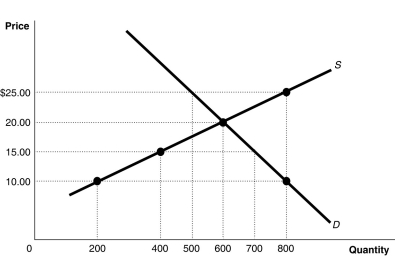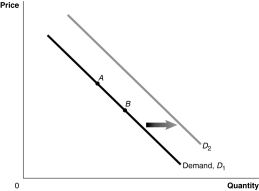Correct Answer

verified
Correct Answer
verified
True/False
If the demand curve for a product shifts to the left and the supply curve for the product shifts to the left,the equilibrium quantity will decrease.
Correct Answer

verified
Correct Answer
verified
Multiple Choice
What would happen in the market for laser eye surgery if insurance companies started to cover a portion of the price of voluntary procedures?
A) Demand will increase,but this will not shift the supply curve.
B) Supply will increase,but this will not shift the demand curve.
C) Demand and supply will both increase.
D) Demand will increase and supply will decrease.
Correct Answer

verified
Correct Answer
verified
Multiple Choice
The Internet has created a new category in the book selling market,namely,the "barely used" book.How does the availability of barely used books affect the market for new books?
A) the demand curve for new books shifts to the right.
B) the demand curve for new books shifts to the left.
C) the supply curve for new books shifts to the right.
D) the supply curve for new books shifts to the left.
Correct Answer

verified
Correct Answer
verified
True/False
As the number of firms in a market decreases,the supply curve will shift to the left and the equilibrium price will rise.
Correct Answer

verified
Correct Answer
verified
Multiple Choice
Which of the following statements is true?
A) An increase in demand causes a change in equilibrium price;the change in price does not cause a further change in demand or supply.
B) A decrease in supply causes equilibrium price to rise;the increase in price then results in a decrease in demand.
C) If both demand and supply increase there must be an increase in equilibrium price;equilibrium quantity may either increase or decrease.
D) If demand decreases and supply increases one cannot determine if equilibrium price will increase or decrease without knowing which change is greater.
Correct Answer

verified
Correct Answer
verified
Multiple Choice
In January,buyers of gold expect that the price of gold will rise in February.What happens in the gold market in January,holding all else constant?
A) The supply curve shifts to the right.
B) The demand curve shifts to the left.
C) The demand curve shifts to the right.
D) The quantity demanded increases.
Correct Answer

verified
Correct Answer
verified
Multiple Choice
Tom Searchinger,a senior attorney at the Environmental Defense Fund,observed that generous farm subsidies have encouraged farmers to produce more corn and more wheat.How does this affect the market for fertilizer?
A) The supply of fertilizer increases.
B) The supply of fertilizer decreases
C) The demand for fertilizer increases.
D) The demand for fertilizer decreases.
Correct Answer

verified
Correct Answer
verified
Multiple Choice
A supply schedule
A) is a table that shows the relationship between the price of a product and the quantity of the product supplied.
B) is a curve that shows the relationship between the price of a product and the quantity of the product supplied.
C) is the relationship between the supply of a good and the cost of producing the good.
D) is a table that shows the relationship between the price of a product and the quantity of the product that producers and consumers are willing to exchange.
Correct Answer

verified
Correct Answer
verified
Multiple Choice
Buyers rush to purchase stocks in California vineyards following a forecast of a 30 percent decline in this year's grape harvest.What happens in the California wine market as a result of this announcement?
A) The demand curve for California wine shifts to the left in anticipation of higher prices in the future.
B) The demand curve for California wine shifts to the right in anticipation of higher prices in the future.
C) The supply curve for California wine shifts to the right in anticipation of higher prices in the future.
D) The supply curve for California wine shifts to the left in anticipation of lower quantities in the future.
Correct Answer

verified
Correct Answer
verified
Multiple Choice
In 2004,hurricanes damaged a large portion of Florida's orange crop.As a result of this,many orange growers were not able to supply fruit to the market.At the pre-hurricane equilibrium price (i.e. ,at the initial equilibrium price) ,we would expect to see
A) a surplus of oranges.
B) the quantity demanded equal to the quantity supplied.
C) a shortage of oranges.
D) an increase in the demand for oranges.
Correct Answer

verified
Correct Answer
verified
Multiple Choice
Figure 3-4  -Refer to Figure 3-4.If the price is $10,
-Refer to Figure 3-4.If the price is $10,
A) there would be a surplus of 600 units.
B) there would be a shortage of 600 units.
C) there would be a surplus of 200 units.
D) there would be a shortage of 200 units.
Correct Answer

verified
Correct Answer
verified
Multiple Choice
If in the market for peaches,the supply curve has shifted to the left,
A) the supply of peaches has increased.
B) the supply of peaches has decreased.
C) the quantity of peaches supplied has increased.
D) the quantity of peaches supplied has decreased.
Correct Answer

verified
Correct Answer
verified
Multiple Choice
One would speak of a change in the quantity of a good supplied,rather than a change in supply,if
A) supplier expectations about future prices change.
B) the price of the good changes.
C) the cost of producing the good changes.
D) prices of substitutes in production change.
Correct Answer

verified
Correct Answer
verified
True/False
Market equilibrium occurs where supply equals demand.
Correct Answer

verified
Correct Answer
verified
True/False
If the number of firms producing mouthwash increases and consumer preference for mouthwash increases,the equilibrium price of mouthwash will definitely increase.
Correct Answer

verified
Correct Answer
verified
Multiple Choice
"The price of compact fluorescent light bulbs fell because of improvements in production technology.As a result,the demand for incandescent light bulbs decreased.This caused the price of incandescent light bulbs to fall;as the price of incandescent light bulbs fell the demand for incandescent light bulbs decreased even further." Evaluate this statement.
A) The statement is false.A decrease in the price of compact fluorescent light bulbs would decrease the demand for incandescent light bulbs,but a decrease in the price of incandescent light bulbs would not cause the demand for incandescent light bulbs to decrease.
B) The statement is false because the demand for incandescent light bulbs would increase as the price of compact fluorescent light bulbs fell.
C) The statement is false because compact fluorescent light bulbs producers would not reduce their prices as a result of improvements in technology;doing so would reduce their profits.
D) The statement is false because it confuses the law of demand with the law of supply.
Correct Answer

verified
Correct Answer
verified
Multiple Choice
During the recession of 2007-2009,despite falling income levels,the fast-food chain Subway experienced increased sales.The increase in demand for Subway sandwiches despite the decline in income indicates that Subway sandwiches are considered
A) normal goods.
B) inferior goods.
C) complementary goods.
D) substitute goods.
Correct Answer

verified
Correct Answer
verified
True/False
An increase in the number of firms in a market will cause the quantity of a good supplied to increase.
Correct Answer

verified
Correct Answer
verified
Multiple Choice
Figure 3-1  -Refer to Figure 3-1.A decrease in the price of the product would be represented by a movement from
-Refer to Figure 3-1.A decrease in the price of the product would be represented by a movement from
A) A to B.
B) B to A.
C) D1 to D2.
D) D2 to D1.
Correct Answer

verified
Correct Answer
verified
Showing 81 - 100 of 149
Related Exams